|
|
|
The use of a Dump is highly recommended in any type of offense. It removes one offense-defense pair from in front of the disc, and opens up the field somewhat. It's mainly used as a safety valve if things bog down (which happens all too often). A side benefit is that it can often be a good tactic to gain an open throw.
The success of the dump (or Iso, which is a forward dump) play depends on the Handler and the Dump knowing what options are available and who will initiate the action (cut versus throw). The general rule is: 1) if the Dump's marker is looking at the Dump, the Handler will initiate action with a throw; or 2) if the Dump's marker is looking at the Handler, the Dump will initiate action with a cut.
The key to setting up a successful dump pass is for the Dump
to stand still behind the Handler (see figure).

Once the Dump is stationary, two things happen: 1) the marker is forced to make a choice of looking at the Handler or the Dump (unless the marker is behind the Dump, of course), and 2) the Handler, as is typically the case, does not have to guess when the Dump has made her/his last fake and is making a real cut.
The Dump's marker may front the Dump or set up slightly behind the Dump at an angle so the Handler and the Dump are both visible. In the case of fronting, the Handler should be a happy camper, as the disc may be thrown to either side of the Dump. In the angle-defense situation, the Dump should casually move back to stand directly behind the marker (then come to a standstill). This will open up the throwing space between the Handler and the Dump, and/or cause the marker to be forced to look at only one of the two offensive players.
If at all possible, the dump pass is to be thrown into the
open space (away from the Handler's marker) lateral to the Handler
(see figure)

This will give the Dump the position for an upfield throw, and the throw won't be impeded by the Handler's position. After making the pass, the Handler then either becomes the new Dump (preferable), or takes a give-and-go pass in return.
One technique that works very well is for the Handler to fake a dump pass to the spot where the Dump is standing (and for the Dump to fake a cut or catch), then make the pass into the flat. At such close range, the Dump's marker almost always falls for the fake.
The type of pass that the Handler makes is that of a flat, short, floating pass which will either be thrown to a spot where the Dump is cutting (when the Dump initiates action), or to a spot where the Handler wants the Dump to cut (when the Handler initiates action). The ability to throw a nice, floating pass is necessary (if this throw is not in your arsenal, please work on it so that you have it).
The dump pass should be made whenever the stall count reaches 7. Also, when in doubt regarding the success of a potential dump, one can do two things: 1) call time out, or 2) huck the disc long (obviously, not the preferred option).
The concept of standing still is fundamental to the success of the dump (and Iso), the Endzone play, and the Break Trap play. The use of this concept will significantly increase the chances of a completed pass anywhere on the field. Remember, turnovers are terminal.
One last point. The Dump's marker will on occasion leave
the Dump and attempt to poach the Handler's throw; sort of a
close-in poach. When this happens, the Dump should move to set up on
the side of the field opposite of the poach (usually the break-force
side of the field) and call for a pass (not waiting for a
high count) (see figure).
